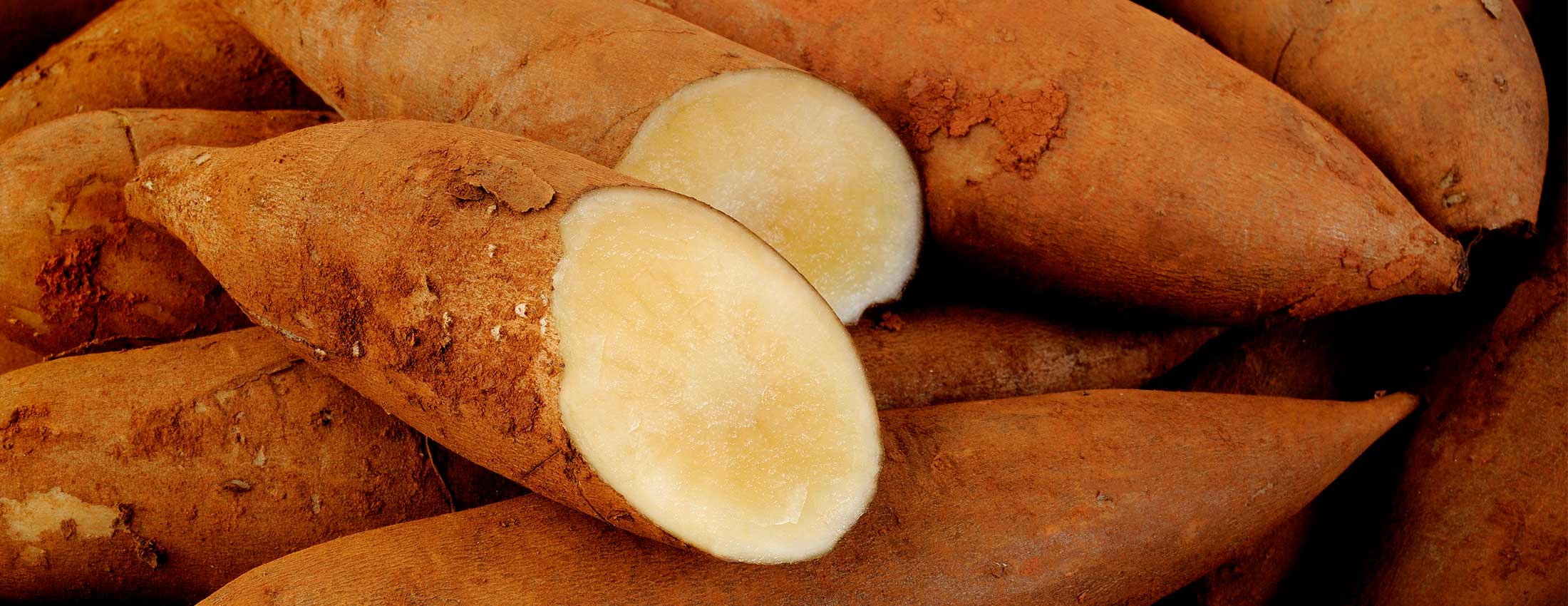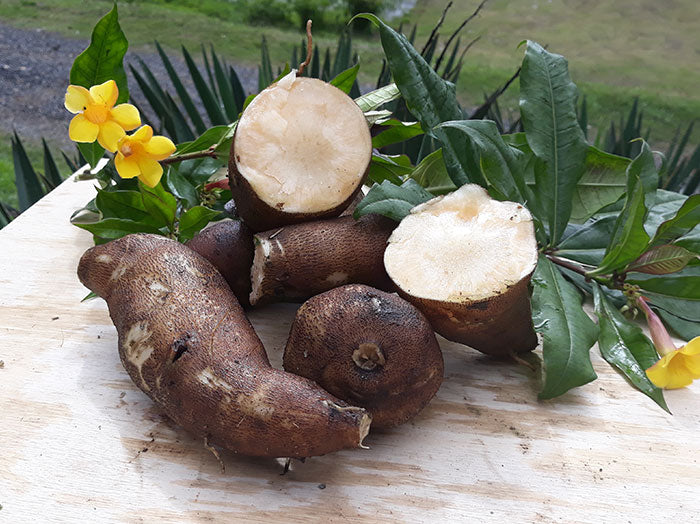The Yacon Opportunity – A Gut-Boosting Superfood

The term “superfood” has been grossly abused, however, when seeking a functional food with multiple health benefits, some worthy candidates still remain...
Chia seed, for example, is deserving of the title, as are tumeric and moringa. However, I have recently become aware of another worthy contender. This food, like chia seed, comes from South America, but it can be grown anywhere in Australia. Australia has become the world’s largest producer of chia, and I would like to see a similar initiative unfold with an exciting root crop called yacon.
My first encounter with yacon, the Peruvian ground apple, took place during a seminar tour of Western Australia last year, when I was generously hosted in Perth by close friends Haydn and Chris. Haydn is a remarkable home gardener, producing a diverse range of chemical-free, nutrient-dense fruit and vegetables upon every square metre of his urban block. Chris is an accomplished worm farmer, and they share a passion, purpose, humour, and love of life that makes every visit a genuine joy.
Yacon is a 2-metre tall, sunflower-like annual that produces an abundance of cream-colored tubers, which are harvested when the large plant dies back in June. The tubers are attached to rhizomes, from which the next generation is spawned.
The sought-after rhizomes become the breeding material for the next crop. Each plant produces around thirty good-sized rhizomes and this becomes a substantial secondary income stream for yacon producers. Each rhizome reliably produces a vigorous new plant, which is best started in a nursery during Winter and transplanted into the soil in Spring.

During my visit, Haydn and Chris treated me to samples of the root in two forms. The first comprised the inclusion of sweet, crunchy slices in salads. The second involved chewy, dried chips, which they called “vegetarian biltong”. Both formats were memorable. The home grown salad was heightened by this apple-like additive, renowned for soaking up and magnifying the juices of surrounding components (including the dressing). The dried root slices were a sweet and savoury treat that would complement any wine or boutique beer.
I was immediately taken with the flavour, texture and synergistic potential of this unique food. However, it was not until Haydn shared information regarding the remarkable health benefits, that I became seriously excited. Just days earlier, I had shared the stage with some of Australia’s leading gut health specialists and they had all sung the praises of prebiotics (substances that stimulate your existing ‘good guys’).
Now, I was suddenly made aware of the most powerful, known, natural prebiotic on the planet, and the benefits did not stop there. I immediately decided to trial this crop, on both farms.
Haydn was able to link me with a local producer, who agreed to sell me over 500 rhizomes. I was also able to source another two hundred rhizomes from Victoria, and my yacon journey had begun.
Preparation of Plant Stock
It was an inauspicious beginning. The rhizomes were delivered in plastic-lined boxes that sat in the hot boot of my rental car for my last day of the WA seminars. When I checked them at day’s end, I was horrified to find that many had sprouted in the moist, warm conditions. Sprouting, with yacon rhizomes, does not involve the emergence of an inconsequential vegetative tip. These plants explode in vegetative exuberance. The first leaf that emerges is huge. The broad new leaves were trying to burst from the restriction of their cardboard containers. In my naivety, I feared that I might lose my exciting new crop before it was even planted.
I flew the sprouting rhizomes back to Queensland in several 20 kg containers, and spent that weekend potting them up in my commercial greenhouse. It turns out that they are very hard to kill. Every rhizome survived the rough start, and that survival instinct continued, regardless of where they were planted out. I trialled just thirty seedlings at my Stanthorpe farm to test their potential in temperate conditions. Stanthorpe is the only region in Queensland that snows. These plants thrived and the yield was exceptional. In my opinion, Yacon can be successfully cropped in any region of Australia, including Tasmania. In fact, they have tremendous potential in any region of the world where there is a minimum frost-free period of 6 months.
Choosing a Profitable Crop: Papaws as a Case Study
The guideline when selecting new crops on your farm should ideally revolve around the concept of multiple potential income streams in the first season. Avocados are the crop of the moment, but it is a patient, well-funded farmer who can wait four years until the first commercial crop.
Papaws are a great example of rapid return on investment in the subtropics. They can produce two crops in the first year, but that is just the beginning. There is a ready market for papaw leaves for the production of anti-cancer formulations. The green papaw (which takes much less time to produce) is more valuable than the ripe fruit. The green fruit contains 40 times more papain (a powerhouse protein digester) than the ripe fruit.
There is a compelling theory that we are born with an inherited capacity to produce a limited number of digestive enzymes with our liver and pancreas. This is like a ‘bank account’, and we draw from it every time we eat dead, enzyme-depleted, processed food. When our unnatural diet speeds the depletion of key digestive enzymes, our metabolic enzymes desert their posts and become digestive enzymes. The system then rapidly crumbles, in the absence of digestion, so this substitution process is prioritised.
These metabolic enzymes typically control every function in our bodies so, when they are reassigned to digestion, the other systems suffer. The wheels begin to fall off rapidly thereafter and, when enough of these systems are compromised, we fall from our perches.
Sorry for the digression here, but I get a bit passionate about food as medicine… Back to crops with multiple income streams.
The green pawpaw can easily be grated, combined with a handful of other ingredients and thus value-added, to produce green papaya salads for sale to restaurants and astute consumers. There is so much wisdom to be found in many traditional practices. You are offered green papaya salad with every protein dish in several Asian countries so that you do not draw from your own, limited, protease bank account.

The ripe pawpaw is an in-demand fruit, and there is even more demand for the sliced and dried version. It is important to choose the red variety, as the taste is more intense and the red color involves the remarkably protective pigment, lycopene.
The seeds can make an anti-parasitic supplement for both livestock and humans. They can also be sun-dried and planted at three-to-a-pot, to ensure that a female is present. The female grows less vigorously than the male, so it is easy to identify and remove the more boisterous males early in the season. Each mature fruit can produce seeds to generate up to 100 pots of seedlings, which can be sold for $3 (AUD) each. In this manner, a single large fruit can generate up to $300!
Hence, we have a crop with seven income streams, and it fruits in the first season!
Yacon – Four Income Streams and a Side Benefit
The yacon, as mentioned, has an immediate market for the delicious tubers, which can be steamed, roasted or eaten raw. The chewy, dried slices are equally appealing, particularly when you understand that the prebiotic potential has been quadrupled (the dehydration process generally concentrates all active components four-fold). Yacon syrup is quite easily produced, and is in huge demand as a problem-free sweetener for diabetics.
As the yacon market develops, the rhizomes may yet prove more profitable for producers than the tubers. They are currently selling for about $1.50 (AUD) each, which provides an additional earning potential of over $40 (AUD) per plant. Finally, the leaf is great fodder for livestock (including chickens, who strip the stalks clean within minutes).

The Top Seven Benefits of Yacon
Residents of the Andes have enjoyed this sweet, juicy root vegetable for over 1000 years, but the recognition and popularity of this food has only recently spread beyond the shores of South America. There are multiple, functional usages of this superfood, but here are the top seven benefits:
1) A powerhouse prebiotic
It has been estimated that there is a 3-billion dollar market potential for prebiotics, as the world awakens to the importance of our “life within”. Our 30-foot digestive tract should house over 100 trillion organisms (ten times the total number of our own cells). This biological bank account funds every aspect of our health and wellbeing, from immune competency to mental wellness. However, we have mercilessly assaulted this microbial workforce with antibiotics, food stabilisers, prescription drugs and artificial sweeteners. There is tremendous benefit in compensating for this onslaught, by feeding and nurturing our inner allies. Prebiotics are substances that feed and stimulate our gut life. The best-researched of these compounds are fructooligosaccharides (FOS) and inulin.
Foods from the allium family, including garlic, leeks and onions, along with foods like bananas and artichokes, feature good levels of these stimulatory compounds. However, the highest known source of FOS and inulin is the yacon plant. It literally serves as a life-enhancing medicine, supporting the creatures that support us on so many levels.
2) An invaluable weight loss tool
Yacon is a recognised regulator of body fat. We have reached a ludicrous point on this planet, where there are as many people overweight as there are starving. In fact, Australian is now climbing the ranks towards being the most accomplished fatties of all. We are not the most obese, but 62% of us are now more than 5 kg above our ideal body weight. Carbohydrates, including sugar, are the biggest players in this battle of the bulge, and this is where yacon shines. It is often called “the diet potato” because it has both low calories and a very low glycemic index. The glycemic index is a measure of how fast any given food spikes our blood sugar. Insulin is produced as a result of this spike, and some of that excess insulin eventually becomes fat. Low fasting blood insulin was the only common denominator in a recent, large-scale, global study of centenarians. In this context, the consumption of low GI food, like yacon, is a serious secret of longevity.
The potato is our favourite vegetable, but it has a higher glycemic index than white sugar (85 vs 70). Yacon can substitute for potato. It satiates for longer and will not spike insulin. In fact, a study published in the Journal of Clinical Nutrition in 2009 revealed that yacon syrup significantly reduced fasting insulin levels while promoting weight loss and suppressing appetite.
3) Reducing cholesterol and triglycerides
High levels of both of these fats are seen as a marker for increased risk of heart attack and stroke. Fructooligosaccharides have been shown to reduce both low density lipoproteins (LDL cholesterol) and triglycerides. This is seen as a protectant against fatty liver, a major health issue impacting our most important organ.
4) Addressing Metabolic Syndrome
Research published in the March 2008 issue of “Food and Chemical Toxicology” revealed a relationship between yacon consumption and reduced risk from Metabolic Syndrome. Metabolic Syndrome involves a collection of elevated markers, which together generate a far greater risk of stroke, heart attack, diabetes and Alzheimer’s disease. In that study, yacon was combined with silymarin, the active ingredient in milk thistle, to reduce all five markers of this precursor condition.

5) Antioxidant impact
The theory of free radical degeneration proposes that these unstable molecules are primary players in premature aging and untimely death. Free radicals lack an outer electron and this instability drives destructive behavior, similar to taking a wrecking ball to neighboring cells. Antioxidants donate an electron to quell these free radical fires. We would all benefit from a dietary boost in antioxidants, and yacon roots (and leaves) qualify as a rich source of these protective substances. Yacon leaf tea contains the three powerful antioxidants – caffeic acid, ferulic acid and chlorogenic acid.
The roots are also anti-inflammatory. They contain resveratrol, the heart protecting compound also found in red wine, and they also contain chlorogenic acid. I had wondered about the reports of relaxation, sleep improvement, and a sense of well-being associated with consumption of yacon roots. It was only when researching for this article that I found a recently published paper from South America, where it was discovered that yacon roots contain a significant percentage of tryptophan. This amino acid/antioxidant is the building block for serotonin and melatonin. Serotonin is the ‘feel good’ hormone, often lacking in the depressed. Melatonin helps us sleep, and it is a major antioxidant and cancer-fighting compound. Yacon boosts both.
6) Conquers constipation
Yacon tubers have been used to combat constipation for centuries in the Andes. However, the modern world has much more need for this remedy. Laxatives are now huge business, as so many struggle with maintaining regularity. We all need to poo at least once a day to excrete spent hormones and other metabolic waste. If we can not make this daily delivery, the outcome can be endocrine disruption and a host of other issues relative to a process called re-toxification (the undesirable re-absorption of waste products).
Yacon tubers counter constipation in two ways. Their prebiotic influence fires the good guys responsible for peristalsis, the rhythmical contraction of the digestive tract, that moves things along in the tube. Probiotic organisms message the digestive tract to squeeze at each stage, including that important last squeeze.
The second laxative impact relates to the high fiber level found in yacon. Unlike high GI potatoes, which have no fiber, these treats are packed with the soluble and insoluble fiber so important for bowel health.
7) Healthy versatility in the kitchen
This sweet root has the crunchy texture of an apple and it is used in both green salads with lemon juice and fruit salads with a little honey. It can also be grated, stir fried, steamed or baked like other root vegetables. The prebiotic-packed leaves can also be used, like grape leaves or cabbage leaves, to wrap other foods. They can also be brewed to make a multi benefit herbal tea.
Sourcing Yacon for Your Farm or Garden
If you are starting to think that yacon might be a worthwhile crop addition to your diversified farming enterprise, then Nutrition Farms can supply commercial quantities of rhizomes, while stock lasts. We should still have several hundred kilograms of rhizomes available, after saving our own seed stock for next season.
Similarly, if you would like to include this superfood tuber in your diet, or plant rhizomes in your garden, you can visit the Nutrition Farms website to source these. Order online from www.nutritionfarms.com, or contact our Nutrition Farms consultant, Kate Whitaker, on +61 7 5472 9900 or kate@nutri-tech.com.au.
